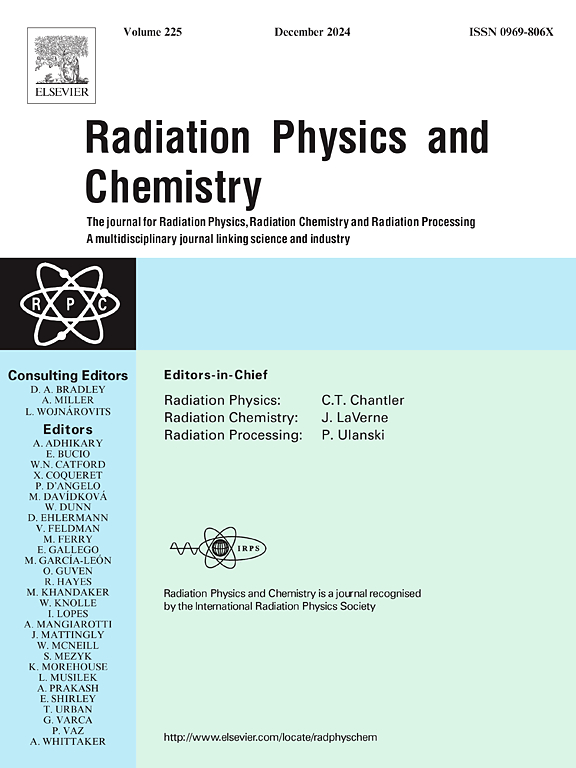硼酸盐基玻璃中氧化钡和氧化锌屏蔽伽马辐射的有效性
IF 2.8
3区 物理与天体物理
Q3 CHEMISTRY, PHYSICAL
引用次数: 0
摘要
本文采用熔淬法制备了一系列新的b2o3 - bao - na20 - zno - cao玻璃体系,研究了其辐射屏蔽性能。所研究的样品编号为G1、G2、G3和G4。研究了BaO和ZnO对玻璃抗辐射能力的影响。ZnO和BaO的加入提高了玻璃密度。例如,G1、G2、G3、G4的密度分别为3.017、3.152、3.287、3.422 g/cm3。采用物理- x程序研究了铕-152辐射源在0.122 ~ 0.678 MeV能量范围内玻璃的辐射屏蔽性能。结果表明,组成为52B2O3-11BaO-8Na2O-16ZnO-13CaO (G4)的玻璃样品具有较高的线性衰减系数(LAC)。例如,在0.1218 MeV下,G1、G2、G3、G4样品的LAC分别为0.821、0.996、1.176、1.362 cm−1。此外,由于BaO和ZnO含量高,该玻璃样品具有较高的Zeff。在0.1218 MeV处,G1、G2、G3和G4的Zeff值分别为14.217、16.651、19.017和21.318。组成为70b2o3 - 5bao - 5na20 - 10zno - 10cao (G1)的玻璃样品具有最高的半值层(HVL)和平均自由程(MFP),与其他样品相比,其屏蔽能力最低。结果表明,G4样品具有最高的屏蔽性能,适合作为辐射屏蔽物质。本文章由计算机程序翻译,如有差异,请以英文原文为准。
Effectiveness of barium oxide and zinc oxide in borate-based glasses for gamma radiation shielding
In this work, the melt-quenching process was employed to prepare a new series of B2 O3 –BaO–Na2 O–ZnO–CaO glass systems to explore their radiation-shielding properties. The samples studied were given the following code: G1, G2, G3 and G4. The effect of BaO and ZnO on the ability of the produced glasses to attenuate radiation was studied. The addition of ZnO and BaO led to enhanced glass density. For example, the density of G1, G2, G3, and G4 is 3.017, 3.152, 3.287, and 3.422 g/cm3 , respectively. The Phy-X program was employed to study the radiation shielding properties of the glasses in the energy range of 0.122–0.678 MeV, emitted from the Eu-152 radioactive source. According to the results, the glass sample with a composition 52B2 O3 –11BaO–8Na2 O–16ZnO–13CaO (G4) had a higher linear attenuation coefficient (LAC) than the other glasses. For example, the LAC at 0.1218 MeV for G1, G2, G3, and G4 samples is 0.821, 0.996, 1.176, and 1.362 cm−1 , respectively. Also, this glass sample possesses a high Zeff due to the high amount of BaO and ZnO. The Zeff values at 0.1218 MeV are 14.217, 16.651, 19.017, and 21.318 for G1, G2, G3, and G4, respectively. The glass sample with the composition of 70B2 O3 –5BaO–5Na2 O–10ZnO–10CaO (G1) has the highest half-value layer (HVL) and mean free path (MFP) among the prepared glasses, meaning the lowest shielding ability compared to other samples. Based on the results, the G4 sample showed the highest shielding properties, making it suitable as a radiation-shielding substance.
求助全文
通过发布文献求助,成功后即可免费获取论文全文。
去求助
来源期刊

Radiation Physics and Chemistry
化学-核科学技术
CiteScore
5.60
自引率
17.20%
发文量
574
审稿时长
12 weeks
期刊介绍:
Radiation Physics and Chemistry is a multidisciplinary journal that provides a medium for publication of substantial and original papers, reviews, and short communications which focus on research and developments involving ionizing radiation in radiation physics, radiation chemistry and radiation processing.
The journal aims to publish papers with significance to an international audience, containing substantial novelty and scientific impact. The Editors reserve the rights to reject, with or without external review, papers that do not meet these criteria. This could include papers that are very similar to previous publications, only with changed target substrates, employed materials, analyzed sites and experimental methods, report results without presenting new insights and/or hypothesis testing, or do not focus on the radiation effects.
 求助内容:
求助内容: 应助结果提醒方式:
应助结果提醒方式:


